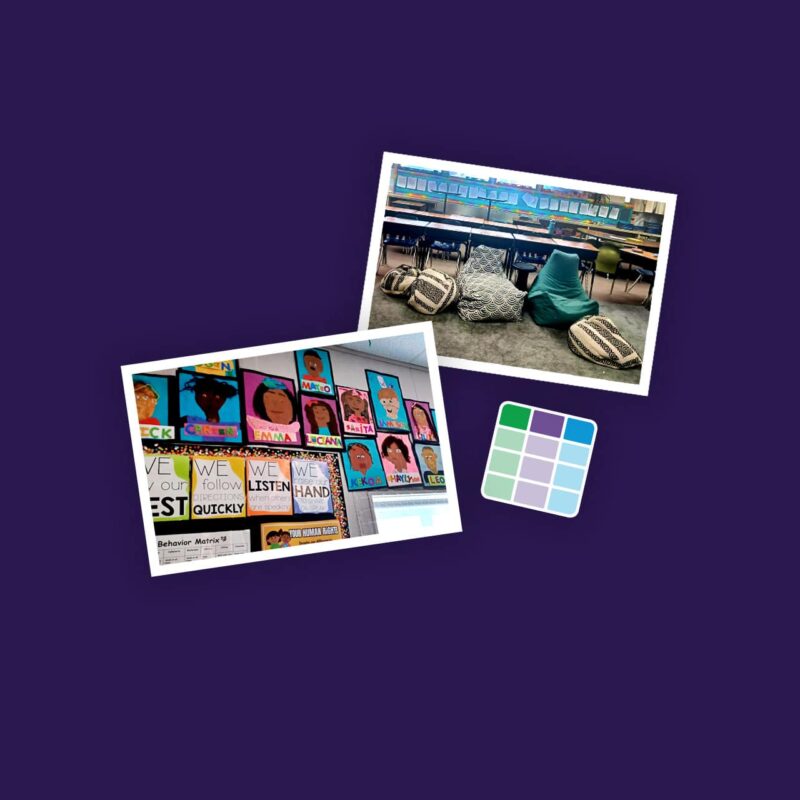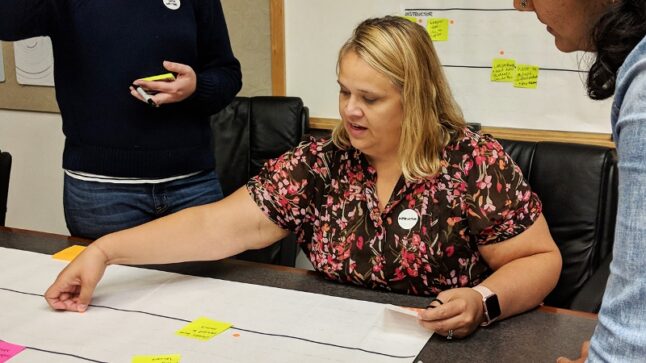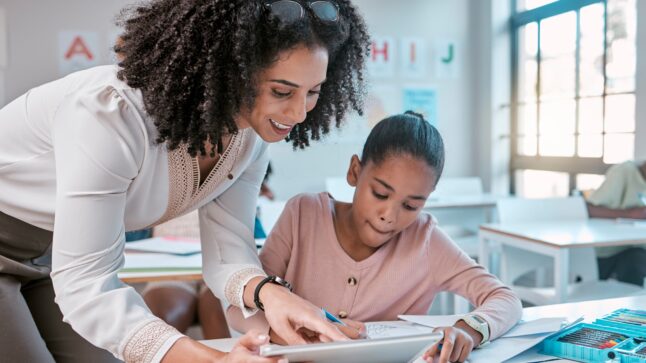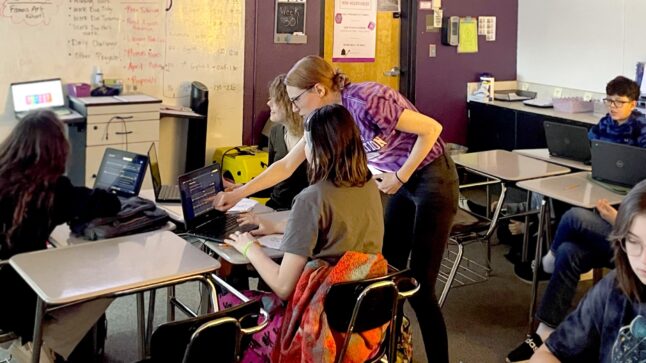Introduction
In 2019, CAST was awarded the Special Education Educator Workforce Investment Grant by the California Department of Education to launch the California Coalition for Inclusive Literacy project, which focused on literacy development using CAST’s UDL implementation model as a driver for systemic improvement. They extended this work in 2023 as a partner and evaluator of the California Coalition for Inclusive Learning (CCIL) project with Placer County Office of Education. The CCIL project aimed to strengthen County Offices of Education partners’ capacity for long-term UDL implementation, which would result in increased rates of inclusion, access, attendance, educator and student agency, and academic achievement across the state of California.
Evaluation by CAST demonstrated that the CCIL project met this goal, and the following Case Study of Bishop Unified School District provides evidence of increased inclusion, attendance, and achievement.
“The teachers are saying, ‘I’m seeing more work than I ever have from these kids.’” Bishop Unified School Administrator
Opportunity
Through the CCIL Project, Inyo County Office of Education launched an initial educator cohort at Bishop Unified School District—a rural district serving 2,000 students, of which 40% are Latine, 15% are Native American, 10% are English Learners, and 15% are enrolled in special education. The district faces significant challenges particular to its rural geography, including limited staffing and students commuting long distances to school. Administrators recognized the potential for how UDL could address Bishop’s struggles with chronic absenteeism. The leaders recognized the need to focus on student engagement and what would motivate students to come to school regularly.
Process: From Cohorts to Systems Focus
Inyo County Office of Education joined the first phase of the California Coalition for Inclusive Learning (CCIL) project, gaining UDL implementation capacity through a train-the-trainer model, followed by whole-staff professional development and teacher and administrator cohorts in the second phase of CCIL.
In the words of Inyo County Office of Education administrator Ilissa Twomey, “What appealed to me about UDL is that students are at the center. In UDL there is a component for student voice and a possibility for more equitable practices and policies.”
Inyo COE administrators worked with two to three professional learning communities at a time, using feedback and an iterative approach to improve over time and personalize trainings for the cohorts they’re working with. In the cohorts, teachers adopted UDL-aligned practices such as collaborative lesson planning, peer observations, and strategies that minimized learning barriers and offered students agency and choice. The district implemented a plan for how every teacher would access the training through the cohort experience. In Summer 2024, nine administrators representing each of Bishop’s schools, along with seven teachers and three county administrators, attended CAST’s three-day UDL-Con in Sacramento. This event was instrumental in gaining deeper understanding and commitment from school leaders because they had time to learn, plan, and collaborate together.
“The hardest thing for me to wrap my head around wasn’t about learning strategies necessarily. It was a mindset—to be able to branch out from more than just looking at choice to move to how to remove barriers,” reflected one teacher.
Moving into a systems-focused approach in 2024 provided an opportunity for administrators to meet in their own leadership PLC to discuss site-based problems of practice and district-wide themes and patterns. Their conversations became more systems-oriented to determine how they might integrate current initiatives through the lens of UDL. UDL is now seen as a way of accomplishing the outcomes of their initiatives rather than as an additional initiative itself. As a result of the administrators’ PLC, communication with teachers about site-wide goals has been clearer, and action steps are in alignment with goals. Staff culture has been prioritized as an integral agent for implementation success, and teacher PLCs have been leveraged to maintain focus on UDL implementation and outcomes.
“We’re still in the growing phase of the craft,” said an administrator at Home Street Middle School. “The hope was that the energy they had would carry over into the next cohorts, and it would gain momentum progressively… and be used in each of the different classrooms across the campus.”
Results and Sustainability
Attendance
Bishop schools have experienced a decline in chronic absenteeism from 2022 to 2024, with progress in nearly all student groups. Decreases from 2023 to 2024 outpaced the state, especially at the middle and high school levels, dropping nine and eight points, respectively, compared to the state decrease of 5 points overall and 2 points at the high school level.
Student Response
Of the student sample surveyed from elementary, middle, and high school classrooms whose teachers have take part in trainings provided through CCIL:
90%
said they understand the learning goals of the work their teacher gives them
79%
said that when they know what is expected of them in a lesson, they try harder to learn
92%
said their teachers offer opportunities for them to use different tools and materials for learning
Inclusion
Bishop Unified School District exceeded state levels of inclusion in regular class 80 percent or more in years 2022–2024, led by inclusion at Bishop Union High, and with an eight-point increase by Bishop Elementary in 2023-24.
Achievement
The percentage of district students with disabilities that placed in the “Prepared” level on the College/Career Indicator was nearly double the state level during the 2023-24 school year (25.9% vs. 13.5%). Bishop Unified also surpassed the state for the four and five-year graduation rate for this population in 2023-24 (82.1% and 85.7%, respectively), showing significant improvement on these metrics from the 2022-23 school year (65.4% and 70.6%, respectively) and outpacing the state in gains.
These early successes have helped with the speed of adoption. A school administrator shared, “Now that they’ve seen it work, it’s much easier to get that buy-in… The teachers are saying, ‘I’m seeing more work than I ever have from these kids. I’m getting more viable work from them.’”
While enthusiasm is high and early results promising, a number of educator cohorts still await formal UDL training, and those who have completed initial trainings are hungry for more time to reflect and collaborate.
“We have amazing educators here,” said one administrator. “I just want them to have more time to do those things and feel like they have the tools necessary to move forward with this type of work.” Plans are in place to expand UDL training through additional grade and content-level cohorts, embed UDL strategies into staff meetings, and increase peer observations and instructional rounds.

UDL Move
UDL Guideline 4: Design Options for Interaction
In a fifth-grade classroom at Bishop Elementary, soft instrumental music plays during independent work. Comfortable seating options invite students to work in the area most supportive to them, be it a wooly rug, a desk, or a standing table. A student wearing headphones types quietly while another uses finger movements in a math game, whispering strategy to a partner. The teacher kneels beside a student working on a laptop, asking, “How did you do on your lesson?” The goals for the lesson are displayed prominently and read aloud to ensure every student knows the expectations. Students are encouraged to express their learning in ways that work for them. One student writes the missing steps in the lyrics of a long division song, while another sings along and dances to memorize the steps. The expectations for learning are high, but the path to progress rests on students’ choices.
Interested in partnering with CAST?
Complete our contact form to find out how we can support your school or district’s PreK-12 program.



